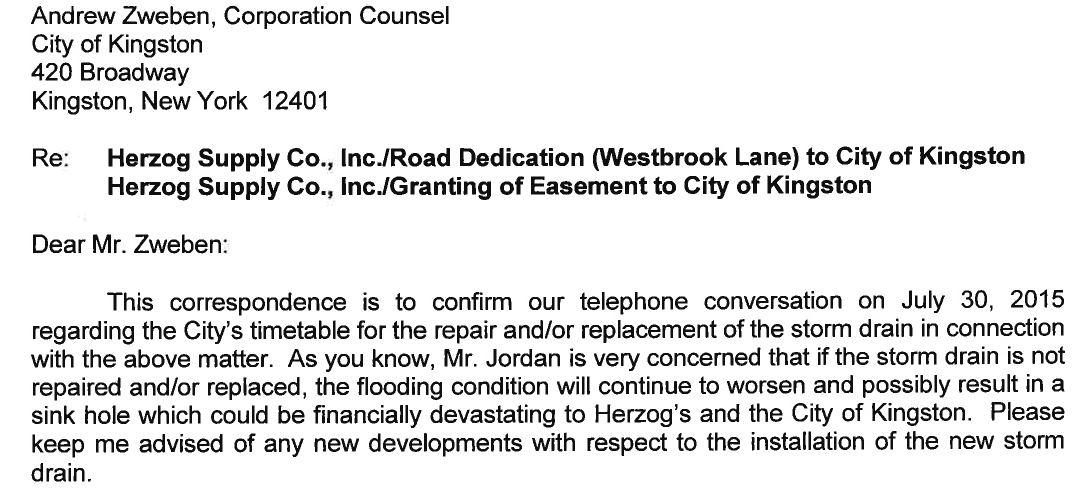Compared with the corporate welfare gushing from Washington, the Kingstonian is a drop in the bucket. Yet corrupt deals of this flavor impact cities large and small across the nation, and in their totality, they defund the people of America perhaps as much as any bailout, subsidy or tax cut of the past five decades. The Kingstonian is the quintessential small town boondoggle, a case study in greed and cronyism, a textbook example of socialization of loss and privatization of profit. A small group of wealthy investors and captured politicians succeeded in foisting the cost of a $58 million luxury housing development almost if not entirely onto the public. The investors, most of whom refuse to be identified and are rumored to include elected officials, are funding their project to the tune of 60.15% through New York State grants and a property tax break. The Opportunity Zone tax break from the Trump tax-cut bill may raise the public subsidy to 100%. Upon sale, the investors will likely pocket around $100 million if they hold for ten years — not bad, considering their cash investment is $6 million. Former Gov. Andrew Cuomo’s support was frequently invoked, so a reasonable question is whether donations helped ram the project past robust community opposition. But that’s dark money, and untraceable, at least by The Vindicator. Lastly, is the project green? No, but it is green-washed.
Who’s Who

The players consist of Team Kingstonian and their allies in government — Kingston’s mayor and Common Council, and the Ulster County executive and most county legislators. Officials who refused to go along with the boondoggle found their jobs on the chopping block. But in elections viewed as a referendum on the tax break, opponents won hands down. Click here for Who’s Who.
Big Lies and Other Tactics
The Biggest Big Lies. The project is at no cost to the public; has “overwhelming” public support; will provide “desperately needed” parking; will lower housing costs in the area, and will create hundreds of jobs and increase tax revenue. Not one of these talking points is true.
Undercover Machinations. Secrecy obtained in proceedings before elected and unelected entities that are supposed to serve the public good. State officials steered cash grants to the Kingstonian, outmaneuvering citizen groups who prioritized other projects. Much was discussed in executive session, meaning that crucial strategizing escaped scrutiny. Bring back transparency, if it ever existed.
Pink Slips. Anyone in a position of authority who disagreed was on the chopping block. Firings took place at the Landmarks Commission, the Industrial Development Agency (IDA) and the Kingston Local Development Corporation (KLDC). Team Kingstonian tried the same trick with KIngston School Board trustees but failed, because those are elected positions and the voters weren’t having it.
Chilling Public Participation. Team Kingstonian rigged a public hearing by refusing to allow online participation during the height of a Covid wave; buried calls for an environmental review; manufactured false flag campaigns against tax break opponents, and gamed which letters were uploaded as public comment.
Cooking the Books. County officials suppressed an economic report that found the Kingstonian would produce a loss to the community and arm-twisted the economic consultant into producing a second study that found a slight benefit.
Conflict of Interest. A tenant, an employee and business associates of Brad Jordan, the property owner, were allowed to cast votes conveying grants, tax breaks and City-owned land parcels worth millions to the project. Jordan himself sat on committees where the grants were under consideration, and he has sat for decades, and still sits, on many important commissions and authorities in Kingston.
Threats. Team Kingstonian claimed they would pull the project if forced to perform an environmental safety study (probably false) and that if the project didn’t go through, millions of dollars in grant money would be withdrawn (definitely false).
Bamboozling Kingston into paying for the Kingstonian may be Jordan’s biggest haul, but it’s not his first. In the mid-aughts, he tried to get Kingston to abandon the perfectly serviceable high school on Broadway and build a new one on a flood plain that he owned near the Esopus tributary. He would have made a fourfold profit upon sale of the flood plain, and since he owns a building supply company, it’s almost certain he would have been involved in the school’s construction.
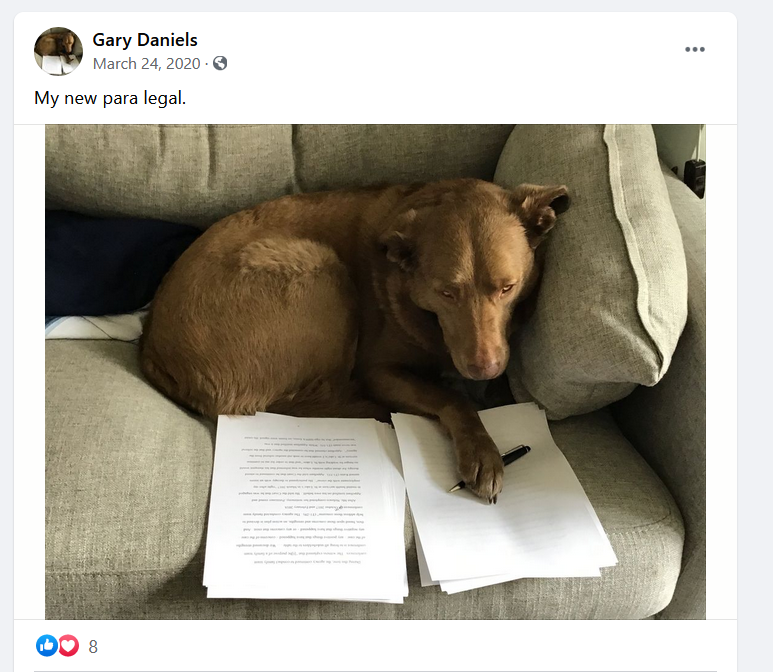
Need more proof Jordan has no problem billing others for any expense he can offload? In 2015, he “dedicated” a street he owned to the City of Kingston to avoid having to repair failing storm sewers that sent water through his lumberyard and onto Kingston Plaza, which he also owns.
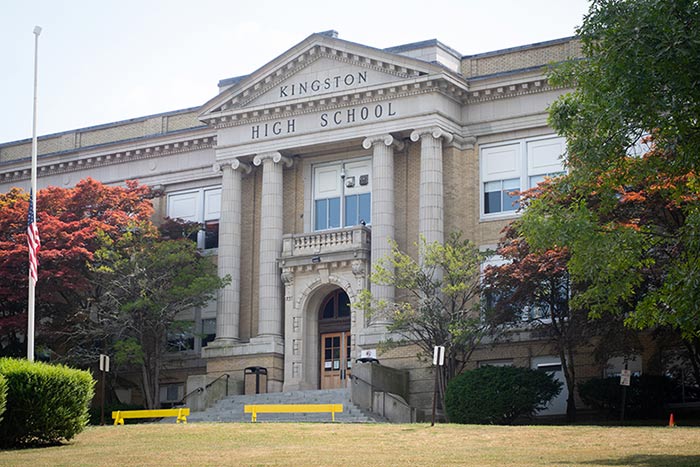
A supporting character pushing for the new school was former City Attorney Dan Gartenstein, later a prime cheerleader for Team Kingstonian, proving that once a lapdog for Brad Jordan, always a lapdog for Brad Jordan. Speaking of dogs, did you notice this Very Good Boy? He belongs to Gary Daniels. That’s Gartenstein’s nom de plume for a fake Facebook page he used to falsely accuse tax break opponents of being on a rival developer’s payroll. Pictures of family members and the doggie, named Bear, were clues the page belonged to Gartenstein.
Sworn in as Kingston’s mayor on Jan. 1, 2016, Steve Noble quickly moved to develop the site. Standing like a vacant eyesore in Kingston’s historic and rapidly gentrifying Uptown was a steeply graded parcel with a small, unkempt park on the high ground, and on the low ground, a parking lot. The last building to stand on that spot, a garage, had to be torn down when concrete started raining from the ceiling.
The parklet, on the high ground, is disparaged as a so-called building tooth gap that sometimes doubles as a garbage can for passers-by.

Facing north, the neglected parklet
The land isn’t the easiest. The lower portion, which is the parking lot, sits on a flood plain atop 100 feet of loose soil before you hit bedrock, which is why the garage started falling apart.
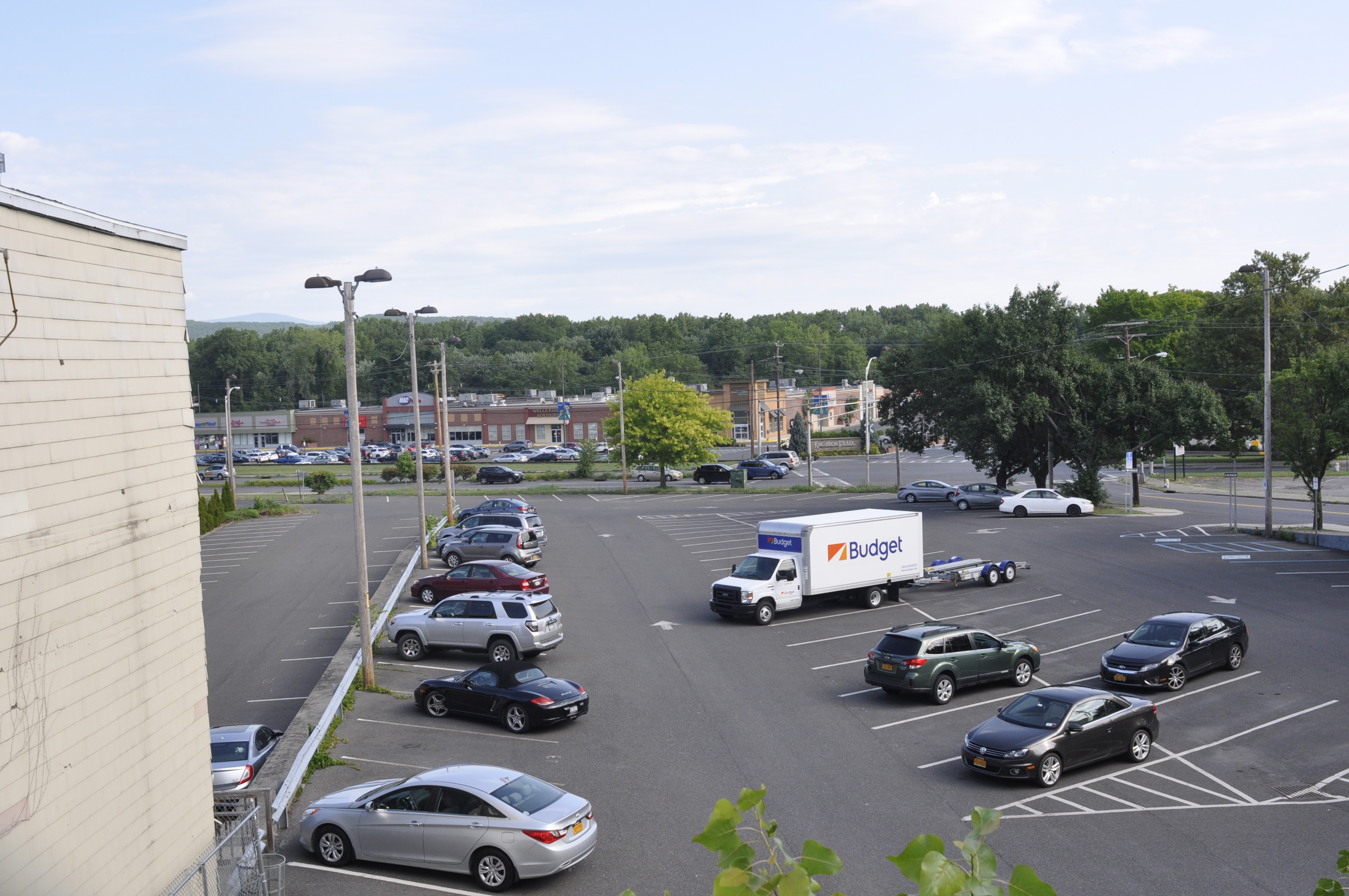
Looking down from parklet lies the 138-car lot. Annual permits cost $100 today. Yearly costs in the new garage will be $720, but only for tenants in the few “affordable” units. Everyone else will pay about $1,200.
That summer, Noble sent out an invitation to develop the property, known as a Request for Qualifications. Soon, Noble and Jordan, who owns the land across the street, agreed to combine the parcels into one gigantic development, which might have been the idea all along. Despite much community opposition, Kingston’s officials would eventually hand over the City’s land and close the street, in total about 1.6 acres, to join with Jordan’s .8 acres.

Facing south, with Jordan’s property on the left, and the former City-owned parking lot on the right. This picture fails to capture the steepness of the rise.
Physical Properties
Reports & Documents
Photos
Geotechnical
Part 1, Scamming the People: Cash from Quid Pro Cuomo
This was the year of the Downtown Revitalization Initiative (DRI). That’s a $10 million grant former Gov. Andrew Cuomo awarded to incentivize redevelopment of smaller cities’ business districts. City Hall submitted the application in June, and in September, Cuomo came to town to announce Kingston had won that year’s competition. Still unclear is why local architect Andrew Wright first signed on as developer of the City’s property but then sold his rights to JM Development, a partnership between Jordan and Poughkeepsie developer Joe Bonura Jr., reportedly for a paltry $50,000.
- Aug. 2016 – Noble releases the RFQ
- Jan. 10 – Wright agrees to develop the City’s property.
- June 15 – DRI Applications are due
- June 19 – Wright assigns his rights to JM Development.
- Sept. 20 – Cuomo announces DRI award, praising “shovel-ready” opportunities.
City Hall set up an online site outlining the process. Noble urged the community to get involved in shaping how to spend the grant money, but in reality, government officials had their thumbs on the scale. Community involvement was for show.
In public, Noble floated endless possibilities. “The “plan” for spending the grant, laid out in bits and pieces by city officials, is at this point more concept, an urban planner’s dream,” wrote local columnist Hugh Reynolds for Hudson Valley1. “Definitive planning, Mayor Steve Noble said, would take up to a year to complete.”
Spectrum reported on projects with civic benefits, such as making it easier for business to operate in Kingston. The clip made no reference to the Kingstonian, but it did note that state and city leaders would be the ultimate arbiters of which projects to fund.
In reality, the planning was already done, and WAMC reported it. “You came up with a great downtown revitalization plan… Commercial, mixed-use development. Bringing residential into the downtown area,” said Cuomo. “It was a brilliant, brilliant plan.”
At the end of the day, the lion’s share of the projects went not to the Uptown Stockade District, but to the marshland below where Brad Jordan wants to create a city below the hill.
2018
Team Kingstonian spent late fall and winter of 2017-2018 putting the final touches on their DRI projects. Kingston put together a Local Planning Committee (LPC), ostensibly to decide how to spend the money. But it was a Potemkin group whose job was to rubber stamp pre-determined projects.
Only a minority of LPC members supported the Kingstonian, including an alderman who was said to be a silent investor and even Brad Jordan himself, who was appointed to the LPC and stayed until someone complained about blatant conflict of interest. The LPC also included representatives from housing and historical groups who should have been the natural opponents of such a project, but who were silenced by a healthy chunk of the DRI grant.
The majority, who wanted the money to go elsewhere, felt compelled to meet in secret because government handlers sent to oversee the process were steering them to the Kingstonian. One LPC member said opponents gave up trying to fight because they felt they had no choice.
DRI money is supposed to benefit business districts. But in this case, the funding did not go to businesses in the Uptown Stockade District, a jewel of centuries-old architecture and narrow streets dating to the mid-1600s. Instead, the grants benefited Brad Jordan and his shopping mall in the former marshland that lies below the Stockade District.
- Feb. 16 – The City releases its “Project Profiles” with a few extraneous ideas thrown in to make it look as if there was a choice.
- March 15 – Kingston releases the finalized and massaged Strategic Investment DRI plan.
- July 2 – Gov. Andrew Cuomo visits Kingston to announce projects to be funded by the $10 million DRI award.
Here was the City’s announcement. Here is the City’s DRI repository with public comments indicating support, opposition, and reservations.
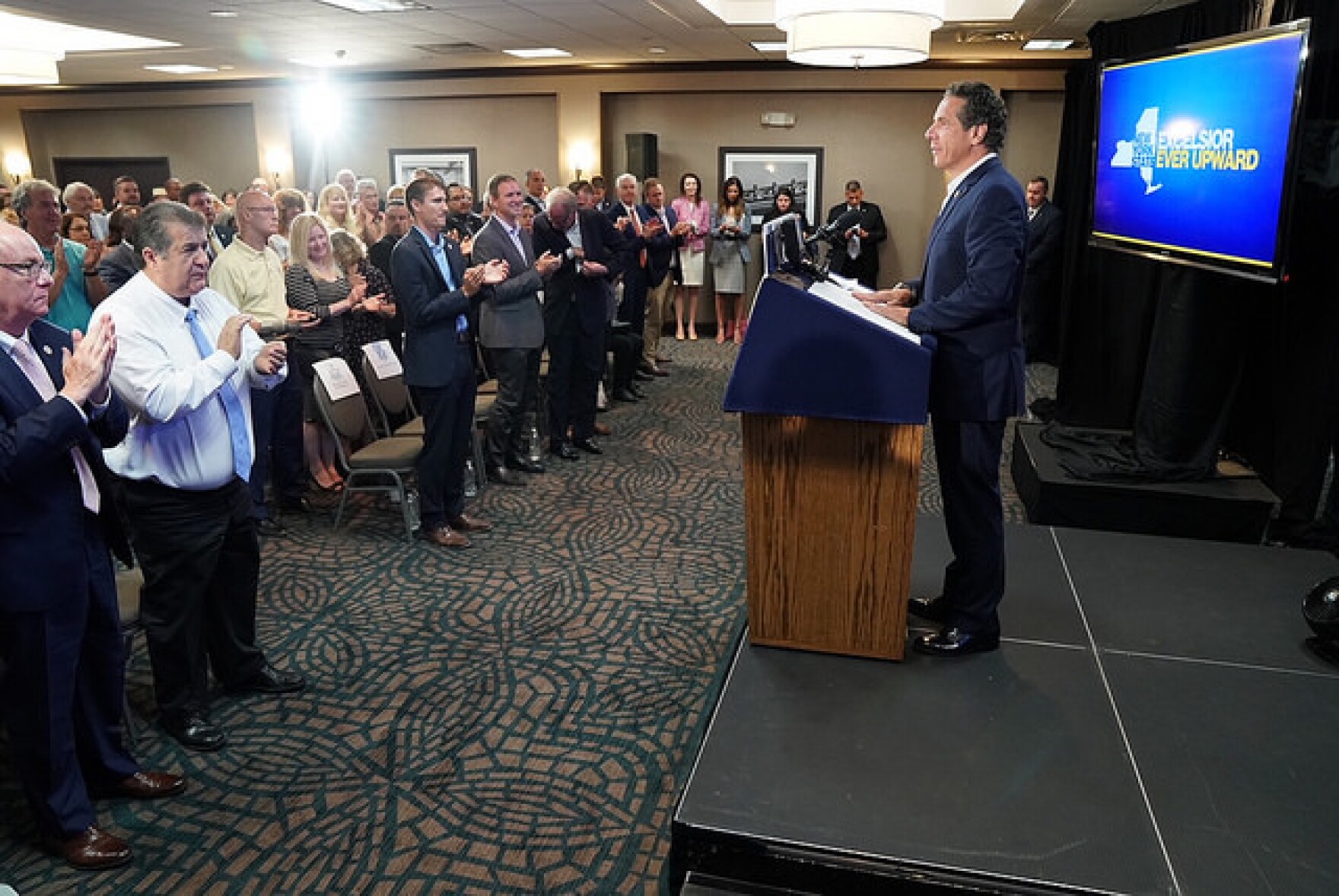
NYS Dept. of State
Steering toward pre-determined outcomes
The DRI Experience
Radio Kingston Interview
with LPC members
DRI Quotes
Quotes and references
LPC members
With DRI money safe in their pockets, the developers launched a PR campaign to drum up public support to overcome the next hurdle. Team Kingstonian’s goal was to avoid a long and expensive environmental review sometimes called for under New York’s SEQR Act. On Nov. 27, the developers submitted their EAF – the application to avoid the environmental review. But the SEQR Act is there for a good reason, and an environmental review today can prevent disasters tomorrow — little things, like the building collapsing because the soil below has the consistency of toothpaste. It also allows for more community input in determining the project’s fate, and that’s the last thing Team Kingstonian wanted. This set the stage for next year’s battle next pitting the developers against anyone who foresaw environmental risks.
Part 2, Scamming the People: Skip Safety Studies
This was the year of the Neg Dec, the “negative declaration” that developers pray for — a finding they can sidestep an expensive environmental review that gives the public more say. Team Kingstonian prevailed by firing or silencing those who disagreed.
- March 19 – Mayor Steve Noble pre-announces the Neg Dec at a Kingston Democratic Committee meeting — even though hearings won’t take place until April and the actual vote won’t take place until December.
- April 2 – The engineer for Team Kingstonian posts that the developers would pull the project if the review is required.
- April 3 – Mayor Noble fires two Landmarks Commissioners because the group unanimously wants a review.
- April 5 – City of Kingston officially, and most improbably, names the SEQR Act as an impediment to fair housing. SEQRA is the New York State law that codifies the people’s right to review risky projects.
- April 10 – At a raucous public hearing, someone reads aloud the Landmarks Commission letter, which otherwise would never have seen the light of day. Written comment is split for and against the review. Forced to include the Landmarks letter, the City uploads only the first page, leaving out the second page containing the actual recommendation for the review.
- May 14 – The local chapter of the Transition group calls for the review in light of the scale, lack of green construction considerations, and emissions from the influx of cars belonging to the new tenants.
- June 3 – Kingston’s Planning Board refuses to accept the Landmarks Commission’s letter calling for the review.
- September 19 – New York’s State Historic Preservation Office (SHPO) finds adverse impacts of the sort that would warrant a review. In particular, it worries about the development’s “visibility.”
- December 16 – The Planning Board hands down the Neg Dec, as expected.
- Feb. 14, 2020 – Under pressure to scrub its opinion, SHPO reverses itself, even though the most significant change in the interim was to add a seventh story — in other words, worsening the visibility problem, which was the adverse impact identified in the first letter. The new letter fails to mention the extra floor.
Go Fund Me
Planning Board hides call for environmental review
Editorial
False promises taint the Kingstonian
Public-Private Spin
Campaign gives developers what they want
Landmarks Firings
Mayor cans commissioners who opposed Neg Dec
Bored To Death
Boring isn’t boring if the building collapses
Was affordable housing a bargaining chip held back to trade for the extra floor and a Neg Dec?

Pleading poverty, Team Kingstonian fought against the inclusion of affordable units. On April 10, 2019, housing advocates demonstrated on the lawn of Kingston City Hall. (Picture, Hudson Valley One.) Local community group KingstonsCitizens.org thought the zoning code required affordable housing, and the developers retaliated with a tirade against the group’s founder. Nevertheless, in October, the developers bowed to community pressure and added 14 units for people earning between 60-110% AMI. Area Median Income (AMI) is calculated on a countywide basis. Using 2020 figures, theoretically this means apartments could be set aside for a breadwinner earning upwards of $82,000 while the spouse stays at home to raise their first child.
Affordable Housing
Developers plead poverty
Green Or Greenwashed
Developers promise little
Part 3, Scamming the People: $28 million Tax Break
The next order of business for Team Kingstonian was to secure almost $30 million in tax breaks. Early 2020 saw the action shift to county government — the County Legislature, the County Executive’s Office, and in particular an unelected authority known as the Industrial Development Agency (IDA), all of which were crucial to okaying the giveaways. The next target of the “firing” squad was the IDA chair, Randall Leverette, who opposed tax breaks for this sort of housing and retail. In fact, the IDA law does not expressly permit such tax breaks and even has language opposing it. Team Kingstonian manufactured a letter-writing campaign, and in some cases, the unsuspecting signatories had no idea the goal was to remove Leverette. By May of 2020, he’s gone.

Astroturf Campaign
Form letters target
tax break opponent
With Leverette out of the way, the path was clear to apply for the tax break. On July 8, Team Kingstonian presented to the IDA. For a look at the lies, exaggerations and hype, please watch the recording or read the lightly annotated transcript.
$30 Million Ask
Team Kingstonian
at IDA July 8
The next obstacles were the policies of the IDA itself. The IDA’s housing policy banned tax breaks for this sort of market rate housing, and the IDA had even reaffirmed the policy in January 2020, when Leverette was still chair. On Aug. 12, the IDA enacted a new rule allowing tax breaks for projects such as the Kingstonian as long as they were approved by Ulster County, the City of Kingston, and the Kingston School Board. For a closer look at the timeline of how the IDA changed one rule after another to benefit Team Kingstonian, please see Whitewash Fails to Persuade.
Public opposition was growing amid doubts the project’s benefits justified the massive tax break. In October, at the behest of a county legislator, County Executive Patrick Ryan hired an independent consultant. The National Development Corporation (NDC) consultant produced a study that found the Kingstonian would cause a $3.4 million loss to the community. Those results didn’t sit well with Team Kingstonian, so Ryan facilitated a meeting among NDC, the developers, the IDA, and county economic development officials. The result: a few days later NDC produced a second study finding a $256,000 benefit to the community. The new IDA chair praised the study as something “we could all live with.” The county tried to bury the first study, but someone promptly leaked it.
"Independent" Review
Long-time pal tapped to gauge benefits
Friends with Benefits
Can’t take kitchen heat,
agrees to cook books
Fake Data
Gamed Numbers Show Gamed Benefits

The last third of the year saw Team Kingstonian ratchet up pressure on the School Board. The IDA housing policy required the approval of the three jurisdictions that would lose money because of the tax break. The Kingston Common Council approved it in August, the Ulster County Legislature followed suit in November, but the School Board, which would lose the lion’s share of the forgone revenue, was proving a tougher nut to crack. County officials phoned to plead with trustees. The developers whined they hadn’t been allowed to present to the full School Board. In reality, the developers had asked to present in private, which is against the law. On Dec. 2, the School Board voted against the tax break. The developers immediately threatened to remove the resistant trustees in School Board elections scheduled for May.
The DRI Grant Is Safe
No matter what they threaten
Opportunism Zones
Lots money and chart
To Tell The Truth
Tall tales taint
Team Kingstonian
Hamburger
Throwing hamburger to the guard dogs 2.0
Fun With Taxes
Explanation of taxes
Part 3 (Cont.), Scamming the People: Finalize Tax Break
On Wednesday, Jan. 20, 2021 the world’s attention was riveted on the swearing in of President Joseph Robinette Biden, Jr. If anyone thought the Trump administration’s corruption and cronyism enriching oligarchs big and small would magically disappear, they were wrong. That same day, Ulster County’s Industrial Development Agency summarily dismissed its own rule requiring school board approval for housing tax breaks, and with the Kingston School Board’s No Vote no longer an obstacle, it proceeded to hand the developers a giveaway of almost $30 million. In March, the county legislature, now clutching its pearls over the boondoggle it enabled, questioned the IDA about its actions. The IDA claimed it acted properly, but the attorney inadvertently let slip the rule change was “an out” — in other words, a maneuver for the sole benefit of Team Kingstonian.
Defunding Education
Tax breaks hurt schoolchildren
IDA Resolutions
Click here for the three
It's All About Me
Team Kingstonian ego shows letters
Eve of the Vote
Mayor cans commissioners who opposed Neg Dec
Truth Will Out
Whitewash Can’t Cover the Dirt

Incumbent School Board President James Shaughnessy
Proxy Vote for Tax Break
It’s about the Kingstonian
not the schoolchildren
The day after the School Board voted down the tax break, Team Kingstonian lashed out with a threat the voters would have a chance to weigh in during May School Board trustee elections. Just in time for the petition deadline, two county officials allied with Team Kingstonian each rustled up a family member in hopes of unseating the incumbents. Once the race was in full swing, Team Kingstonian denied the challenge was linked to the tax break, with the wife of a Common Council member who supported the project calling anyone who suspected otherwise “paranoid.” But an IDA member who is a tenant of Jordan’s was quoted as lamenting that his “side” could find only two candidates willing to run. Alas for his “side,” the voters rightly perceived the race as a referendum on the tax break, and they overwhelmingly returned the incumbents to office, dashing developer hopes for a repeat School Board vote that this time would approve the tax break.

The election fallout continued. In a vote widely seen as a referendum on the Kingstonian, political newcomer and farmer Phil Erner (right) primaried David Donaldson (left), longtime Democratic leader in the Ulster County Legislature, and to almost everyone’s surprise, won. The Democratic machine, which supported the Kingstonian, failed to put much effort behind Erner’s campaign. Donaldson ran on a new party line called “Good Government” but was soundly defeated in the general election Nov. 2.

Part 4, Scamming the People: Privatize Public Land
With the DRI grant, the Neg Dec and the tax break secure, Team Kingstonian could now focus on its fourth freebie: the taking of public lands. The job was to gift the developers the City-owned parking lot/parklet, as well as the street bisecting the future development. The first was accomplished via a local group of cronies called the Kingston Local Development Corporation. (The word “development” in a quasi-governmental body is a good indication it’s a corrupt cesspool.) The street transfer was accomplished by a feat of Orwellian doublespeak — doing it, but saying it wasn’t so.
- Jan. 29 – Mayor Noble asks Common Council to okay transfer of parking lot to KLDC
- Whnever – Common Councils agrees to transfer parking lot
- KLDC hires lawyer to make sure they’re not legally liable
- Aug. 3 – KLDC transfers parking lot to developers
- Aug. 3 – Noble sends absurd letter to Albany higher ups justifying the transfer
KLDC Pay to Play
More stench of corruption
KLDC Conflict of Interest
Enmeshed business interests prevail
Jordan Conflict of Interest
Shadow Mayor
Part 4 (Cont.) Scamming the People: Privatize Public Land
All I want for Christmas is a rigged hearing, sang the developers, and Santa obliged with a stipulation full of holiday cheer for Team Kingstonian. The problem started when a December 2021 public hearing about the closure of Fair Street Extension was rescheduled for January 2022. The court-supervised stipulation required that the new meeting be held in person but was silent on whether it had to also be hybrid. At the time of the stipulation, Dec. 13, 2021, it was clear that another Covid wave was on the way. Team Kingstonian blocked requests for online participation, and sure enough, the wave crested in mid-January, perfectly timed to keep opponents away from the second, Jan. 12, 2022 hearing. Project supporters came out in force, enabling Team Kingstonian to crow about overwhelming community support. It was unclear why the auditorium, at a local public school, wasn’t set up for hybrid meetings.
Fair Street Extension Giveaway by Any Other Name Is Still a Giveaway
- Nov. 9 – Common Council approves two easements to build on FSE
- Dec. 2 – Hearing on FSE closure is marred by technical difficulties
- Dec. 8 – Common Council votes to close FSE via Resolution 251
- Dec. 13 – Judge rescinds vote, calls for new in-person hearing
- Jan. 11 – Noble repeats Big Lies in letter to clear “misinformation”
- Jan. 12 – In-person hearing at height of Covid wave keeps many away
- Feb. 11 – Common Council votes to close FSE
Fact-Free Pols
De facto privatization
Rigged Hearing
Covid Chills Public Comment
FSE Q&A
KingstonCitizens

